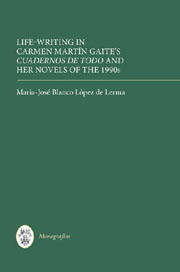Book contents
- Frontmatter
- Contents
- Dedication
- Acknowledgements
- Introduction
- 1 Letters, Diaries and Self-Reflective Writing
- 2 Cuadernos de todo: Carmen Martín Gaite's Diaries
- 3 Nubosidad variable: Letters and Diaries, Female Friendship through Writing
- 4 La Reina de las Nieves: a Personal Search through Diaries and Letters
- 5 Lo raro es vivir: Personal Reflections from Historical Research
- 6 Irse de casa: Life through the Cinematographic Lens, Writing One's Own Life-Script
- Conclusion
- Bibliography
- Index
6 - Irse de casa: Life through the Cinematographic Lens, Writing One's Own Life-Script
Published online by Cambridge University Press: 05 April 2013
- Frontmatter
- Contents
- Dedication
- Acknowledgements
- Introduction
- 1 Letters, Diaries and Self-Reflective Writing
- 2 Cuadernos de todo: Carmen Martín Gaite's Diaries
- 3 Nubosidad variable: Letters and Diaries, Female Friendship through Writing
- 4 La Reina de las Nieves: a Personal Search through Diaries and Letters
- 5 Lo raro es vivir: Personal Reflections from Historical Research
- 6 Irse de casa: Life through the Cinematographic Lens, Writing One's Own Life-Script
- Conclusion
- Bibliography
- Index
Summary
Irse de casa (1998) is the last of Martín Gaite's novels to be published in her lifetime. It shares some of the structure and themes of her other novels of the 1990s, but at the same time reveals a parallel with the author's first novel, Entre visillos (1958), especially in the number of characters present and voices heard. The novel is narrated in the third person singular with an omniscient narrator, allowing the reader to be witness to the lives of the novel's various characters at different times in their histories. As Jurado Morales notes: ‘necesita de un narrador externo que logre hilvanar con verosimilitud esos fragmentos y encauzar el argumento hacia su final sin quedar nada suelto.’ The epigraphs of the novel, from Aldous Huxley and Clarice Lispector, in fact, refer to the idea of a history formed by many stories, and one of the characters of the novel, Florita, comments: ‘Gente … lo que hay que añadir a ese argumento es gente. … Gente que vaya contando también sus historias, … un choque de historias.’ The third-person narration and the way the narrative is presented from not just one perspective takes away some of the intimate atmosphere of the earlier novels discussed here.
In Irse de casa, Amparo Miranda, a sixty-three-year-old woman resident in the United States, returns to her Spanish home town after forty years of absence. The reason for her journey, the reader learns, is the film script her son Jeremy has written, La calle del olvido, which will be the catalyst for her life-writing.
- Type
- Chapter
- Information
- Life Writing in Carmen Martín Gaite's 'Cuadernos de todo' and her Novels of the 1990s , pp. 180 - 198Publisher: Boydell & BrewerPrint publication year: 2013



